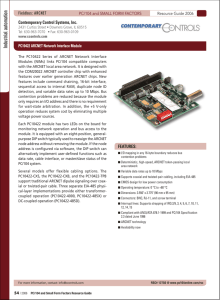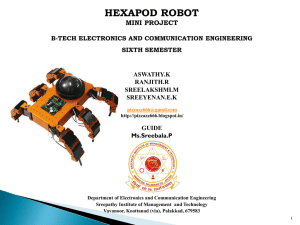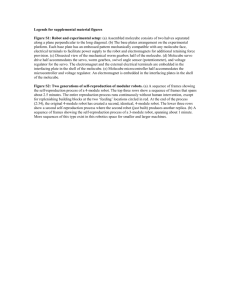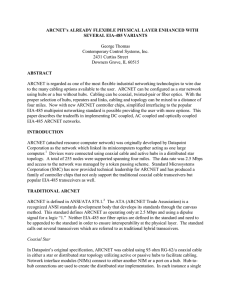Robotics and Contemporary Controls PCI20U
advertisement
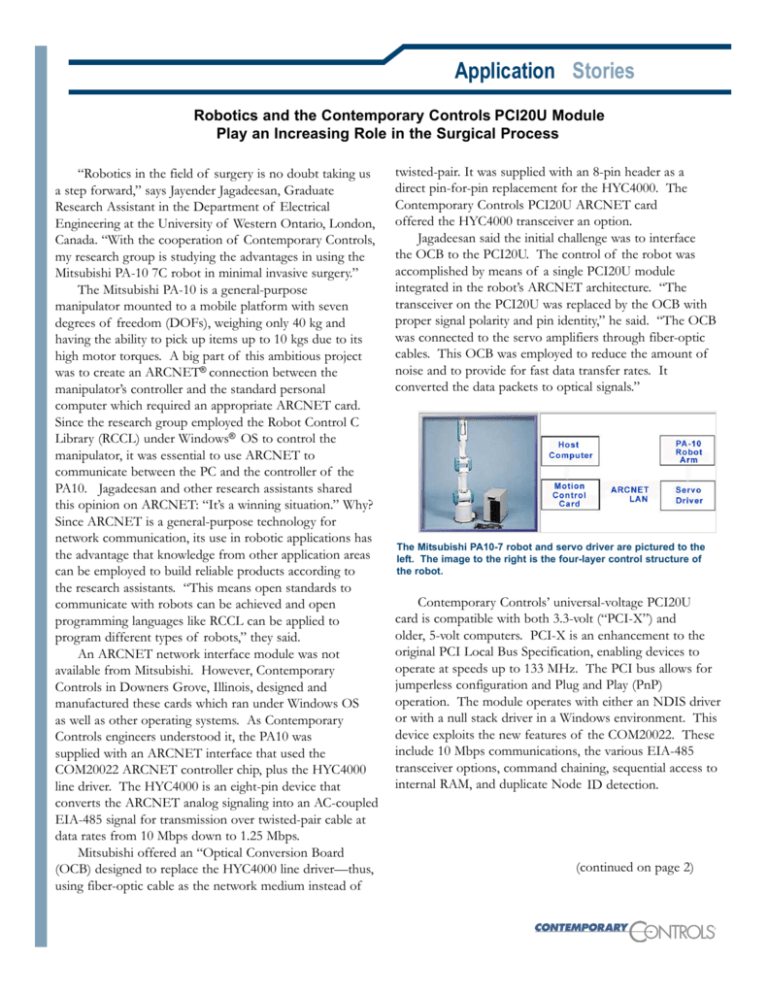
Application Stories Robotics and the Contemporary Controls PCI20U Module Play an Increasing Role in the Surgical Process “Robotics in the field of surgery is no doubt taking us a step forward,” says Jayender Jagadeesan, Graduate Research Assistant in the Department of Electrical Engineering at the University of Western Ontario, London, Canada. “With the cooperation of Contemporary Controls, my research group is studying the advantages in using the Mitsubishi PA-10 7C robot in minimal invasive surgery.” The Mitsubishi PA-10 is a general-purpose manipulator mounted to a mobile platform with seven degrees of freedom (DOFs), weighing only 40 kg and having the ability to pick up items up to 10 kgs due to its high motor torques. A big part of this ambitious project was to create an ARCNET® connection between the manipulator’s controller and the standard personal computer which required an appropriate ARCNET card. Since the research group employed the Robot Control C Library (RCCL) under Windows® OS to control the manipulator, it was essential to use ARCNET to communicate between the PC and the controller of the PA10. Jagadeesan and other research assistants shared this opinion on ARCNET: “It’s a winning situation.” Why? Since ARCNET is a general-purpose technology for network communication, its use in robotic applications has the advantage that knowledge from other application areas can be employed to build reliable products according to the research assistants. “This means open standards to communicate with robots can be achieved and open programming languages like RCCL can be applied to program different types of robots,” they said. An ARCNET network interface module was not available from Mitsubishi. However, Contemporary Controls in Downers Grove, Illinois, designed and manufactured these cards which ran under Windows OS as well as other operating systems. As Contemporary Controls engineers understood it, the PA10 was supplied with an ARCNET interface that used the COM20022 ARCNET controller chip, plus the HYC4000 line driver. The HYC4000 is an eight-pin device that converts the ARCNET analog signaling into an AC-coupled EIA-485 signal for transmission over twisted-pair cable at data rates from 10 Mbps down to 1.25 Mbps. Mitsubishi offered an “Optical Conversion Board (OCB) designed to replace the HYC4000 line driver—thus, using fiber-optic cable as the network medium instead of twisted-pair. It was supplied with an 8-pin header as a direct pin-for-pin replacement for the HYC4000. The Contemporary Controls PCI20U ARCNET card offered the HYC4000 transceiver an option. Jagadeesan said the initial challenge was to interface the OCB to the PCI20U. The control of the robot was accomplished by means of a single PCI20U module integrated in the robot’s ARCNET architecture. “The transceiver on the PCI20U was replaced by the OCB with proper signal polarity and pin identity,” he said. “The OCB was connected to the servo amplifiers through fiber-optic cables. This OCB was employed to reduce the amount of noise and to provide for fast data transfer rates. It converted the data packets to optical signals.” The Mitsubishi PA10-7 robot and servo driver are pictured to the left. The image to the right is the four-layer control structure of the robot. Contemporary Controls’ universal-voltage PCI20U card is compatible with both 3.3-volt (“PCI-X”) and older, 5-volt computers. PCI-X is an enhancement to the original PCI Local Bus Specification, enabling devices to operate at speeds up to 133 MHz. The PCI bus allows for jumperless configuration and Plug and Play (PnP) operation. The module operates with either an NDIS driver or with a null stack driver in a Windows environment. This device exploits the new features of the COM20022. These include 10 Mbps communications, the various EIA-485 transceiver options, command chaining, sequential access to internal RAM, and duplicate Node ID detection. (continued on page 2) However, the robot could be programmed to cancel out these tremors which which can be considered high frequency components.” The Mitsubishi PA-10 is programmed according to how a surgeon would function in the same condition. “In fact, most robots being developed in the medical field are the master-slave type: the surgeon works on the master, while the robot follows the motion of the surgeon’s fingers,” said Jagadeesan. “Surgeons and robots like the PA-10 will continue to work together, leading to more sophisticated methods in medical applications. This in turn means that networking components like the PCI20U will continue to help with these evolving requirements.” In addition to its many features, the PCI20U module has two LEDs on the board monitoring network operation and the bus access to the module. It is equipped with an 8-position, general-purpose DIP switch which could be used to reassign the ARCNET node address without removing the module. Ultimately, the node address is configured via software so the DIP switch can be used for userdefined functions. In the PA-10 ARCNET architecture, the host computer acts as the transmitting node and the servo amplifiers act as the receiving node. The packets are sent in a particular format from the host to the servo. The servo receives the packet and decodes the torque value to each of the seven joints of the robot. There are seven CPUs which individually control each of the joints, collectively acting as a node in the ARCNET network. “When a torque command is given to the servo driver from the computer, the data packet is decoded and the torque is provided to each of the seven joints for robot control,” stated Jagadeesan. “The extra degree of freedom could be used to avoid obstacles and singular points where the control breaks down. It also has the ability of being mounted either from the ceiling or the walls, which provides additional freedom of movement.” He explained that the robot has three categories of control: 1) Joint-based control — each of the seven joints is controlled to follow a desired trajectory, 2) Cartesian control — the robot is controlled to follow a desired trajectory in Cartesian space and 3) Force control — the robot is controlled based on the forces, which are felt at the tip as measured by the 6-DOF force sensor. Jagadeesan concluded that there are significant advantages in employing robots like the PA-10 for minimal invasive surgery. “Robots help in reducing the operating time, thereby reducing costs,” he said. “The amount of trauma involved is far less compared to conventional surgeries since the incision size is very small, leading to quicker discharge of the patient. For extremely complicated surgeries (like operating on babies or performing brain surgery), it is essential to keep the hand as still as possible without any tremors. We know that it is impossible to keep the human hand steady continually.
